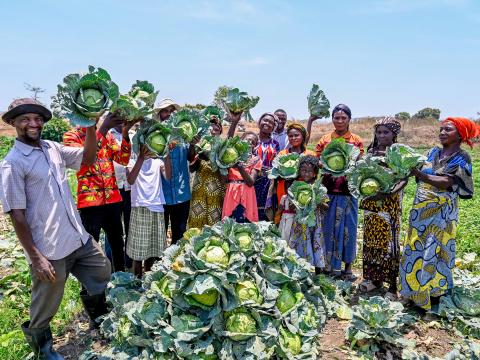DR Congo: How The Market Gardening Is Boosting Community Resilience In Sambwa AP

Around 30 kilometres from Lubumbashi, in the Haut-Katanga province of the DRC, the community of Sambwa relies heavily on family farming, which is largely affected by seasonal variations. The rainy season, from November to April, is followed by a long dry season when the lack of rainfall severely limits production. Recent climate analyses show that the rainy season is shortening and rainfall is decreasing, weakening household incomes and food security.
Local associations such as Mapendo are particularly affected by these changes. During the dry season, they face shortages of farming inputs and higher transport costs.
“During the dry season, we cultivated very little. Fertiliser and seeds were scarce, and the harvests were poor,” explains Mr Kibale Delphin, president of the Mapendo association.
To address this challenge, World Vision DRC supported Mapendo in 2025 through its livelihoods development programme. The support included the provision of 195 bags of fertiliser and a variety of vegetable seeds (cabbage, onion, spring onion, aubergine and pepper) distributed across the Sambwa, Makoulo and Kitanda areas. Technical assistance was also provided through training sessions on organic manure management, crop rotation, pest control, and community field schools designed to strengthen farmers’ practical skills.
On the Kawama site, Mapendo set up a collective experimental field of about 250 m². Members applied the new techniques they had learned, including bed planning, regular watering and plant health monitoring. Sowing began in May 2025, and the cabbage harvest in September provided an opportunity to compare organic manure with chemical fertiliser.
The results were clear:
“Where we applied manure, production was much better. It’s a lesson we will not forget,”says Mr Kibale.
Each bed, containing around 500 cabbage plants, produced encouraging yields. The first harvest, sold locally, generated 250,000 Congolese francs (around 100 USD), which was deposited in a community fund managed by an elected three-member committee. This fund will now serve as capital for reinvestment in the next farming cycle. The second bed, still being harvested, is expected to generate a similar amount, bringing the total income to about 500,000 CDF (200 USD).
These results demonstrate the profitability of collective vegetable farming and strengthen farmers’ confidence in sustainable practices. Members now plan to diversify their crops with short-cycle vegetables such as amaranth, lettuce and peppers to ensure continuous production and stable income.
Building on this success, the Mapendo association aims to expand the model to the three villages within the Sambwa area. Farmers will be encouraged to combine individual plots with collective training sessions, an approach considered effective for strengthening self-reliance while maintaining community solidarity.
“We want each member to have their own plot while continuing to learn together. That’s how we will strengthen our community,” says Mr Kibale.
The support in inputs and technical guidance has enabled the Sambwa community to make significant progress. In a single season, farmers have improved productivity, established a local governance system for resource management, and introduced reinvestment mechanisms. Farming practices have evolved towards greater use of organic manure, crop rotation and better water management.
Field observations indicate that limited but targeted support can foster real capacity building and greater autonomy among farmers. Collective learning and the establishment of management rules help fill what is usually an inactive farming period, keeping agricultural activity ongoing and improving food availability at the community level.
This initiative is part of World Vision’s ENOUGH campaign, which focuses on preventing malnutrition by promoting local production and dietary diversity. The dry-season gardening activities, reinvestment of income, and spread of sustainable practices all contribute to the campaign’s goal: ensuring that children and their families have “enough” to grow up healthy and strong.